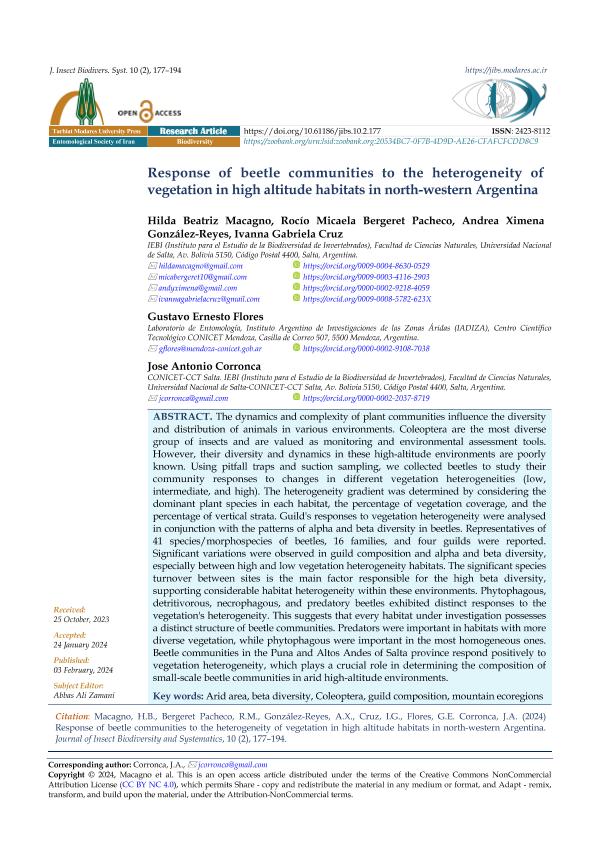Mostrar el registro sencillo del ítem
dc.contributor.author
Macagno, Hilda Beatriz

dc.contributor.author
Bergeret Pacheco, Rocío Micaela

dc.contributor.author
González Reyes, Andrea Ximena
dc.contributor.author
Cruz, Ivanna Gabriela

dc.contributor.author
Flores, Gustavo Ernesto

dc.contributor.author
Corronca, Jose Antonio

dc.date.available
2024-03-25T13:16:31Z
dc.date.issued
2024-02
dc.identifier.citation
Macagno, Hilda Beatriz; Bergeret Pacheco, Rocío Micaela; González Reyes, Andrea Ximena; Cruz, Ivanna Gabriela; Flores, Gustavo Ernesto; et al.; Response of beetle communities to the heterogeneity of vegetation in high altitude habitats in north-western Argentina; Tarbiat Modares University; Journal of Insect Biodiversity and Systemantics; 10; 2; 2-2024; 177-194
dc.identifier.issn
2423-8112
dc.identifier.uri
http://hdl.handle.net/11336/231455
dc.description.abstract
The dynamics and complexity of plant communities influence the diversity and distribution of animals in various environments. Coleoptera are the most diverse group of insects and are valued as monitoring and environmental assessment tools. However, their diversity and dynamics in these high-altitude environments are poorly known. Using pitfall traps and suction sampling, we collected beetles to study their community responses to changes in different vegetation heterogeneities (low, intermediate, and high). The heterogeneity gradient was determined by considering the dominant plant species in each habitat, the percentage of vegetation coverage, and the percentage of vertical strata. Guild's responses to vegetation heterogeneity were analysed in conjunction with the patterns of alpha and beta diversity in beetles. Representatives of 41 species/morphospecies of beetles, 16 families, and four guilds were reported. Significant variations were observed in guild composition and alpha and beta diversity, especially between high and low vegetation heterogeneity habitats. The significant species turnover between sites is the main factor responsible for the high beta diversity, supporting considerable habitat heterogeneity within these environments. Phytophagous, detritivorous, necrophagous, and predatory beetles exhibited distinct responses to the vegetation's heterogeneity. This suggests that every habitat under investigation possesses a distinct structure of beetle communities. Predators were important in habitats with more diverse vegetation, while phytophagous were important in the most homogeneous ones. Beetle communities in the Puna and Altos Andes of Salta province respond positively to vegetation heterogeneity, which plays a crucial role in determining the composition of small-scale beetle communities in arid high-altitude environments.
dc.format
application/pdf
dc.language.iso
eng
dc.publisher
Tarbiat Modares University
dc.rights
info:eu-repo/semantics/openAccess
dc.rights.uri
https://creativecommons.org/licenses/by-nc-sa/2.5/ar/
dc.subject
ARID AREAS
dc.subject
BETA DIVERSITTY
dc.subject
COLEOPTERA
dc.subject
GUILD COMPOSITION
dc.subject
MOUNTAIN ECOREGIONS
dc.subject.classification
Ecología

dc.subject.classification
Ciencias Biológicas

dc.subject.classification
CIENCIAS NATURALES Y EXACTAS

dc.title
Response of beetle communities to the heterogeneity of vegetation in high altitude habitats in north-western Argentina
dc.type
info:eu-repo/semantics/article
dc.type
info:ar-repo/semantics/artículo
dc.type
info:eu-repo/semantics/publishedVersion
dc.date.updated
2024-03-19T14:28:39Z
dc.journal.volume
10
dc.journal.number
2
dc.journal.pagination
177-194
dc.journal.pais
Irán

dc.description.fil
Fil: Macagno, Hilda Beatriz. Universidad Nacional de Salta. Facultad de Ciencias Naturales. Instituto para el Estudio de la Biodiversidad de Invertebrados; Argentina. Consejo Nacional de Investigaciones Científicas y Técnicas. Centro Científico Tecnológico Conicet - Salta; Argentina
dc.description.fil
Fil: Bergeret Pacheco, Rocío Micaela. Universidad Nacional de Salta. Facultad de Ciencias Naturales. Instituto para el Estudio de la Biodiversidad de Invertebrados; Argentina
dc.description.fil
Fil: González Reyes, Andrea Ximena. Universidad Nacional de Salta. Facultad de Ciencias Naturales. Instituto para el Estudio de la Biodiversidad de Invertebrados; Argentina
dc.description.fil
Fil: Cruz, Ivanna Gabriela. Universidad Nacional de Salta. Facultad de Ciencias Naturales. Instituto para el Estudio de la Biodiversidad de Invertebrados; Argentina. Consejo Nacional de Investigaciones Científicas y Técnicas. Centro Científico Tecnológico Conicet - Salta; Argentina
dc.description.fil
Fil: Flores, Gustavo Ernesto. Consejo Nacional de Investigaciones Científicas y Técnicas. Centro Científico Tecnológico Conicet - Mendoza. Instituto Argentino de Investigaciones de las Zonas Áridas. Provincia de Mendoza. Instituto Argentino de Investigaciones de las Zonas Áridas. Universidad Nacional de Cuyo. Instituto Argentino de Investigaciones de las Zonas Áridas; Argentina
dc.description.fil
Fil: Corronca, Jose Antonio. Universidad Nacional de Salta. Facultad de Ciencias Naturales. Instituto para el Estudio de la Biodiversidad de Invertebrados; Argentina. Consejo Nacional de Investigaciones Científicas y Técnicas. Centro Científico Tecnológico Conicet - Salta; Argentina
dc.journal.title
Journal of Insect Biodiversity and Systemantics
dc.relation.alternativeid
info:eu-repo/semantics/altIdentifier/url/https://www.biotaxa.org/jibs/article/view/83955
dc.relation.alternativeid
info:eu-repo/semantics/altIdentifier/doi/http://dx.doi.org/10.61186/jibs.10.2.177
Archivos asociados
